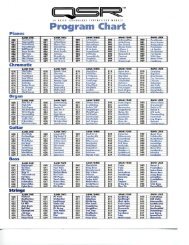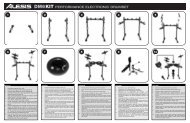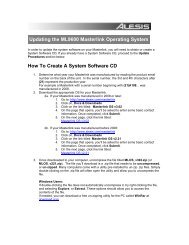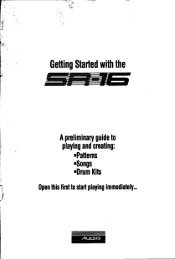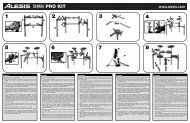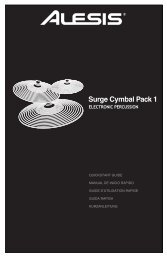MultiMix 8 FireWire - Reference Manual - Alesis
MultiMix 8 FireWire - Reference Manual - Alesis
MultiMix 8 FireWire - Reference Manual - Alesis
Create successful ePaper yourself
Turn your PDF publications into a flip-book with our unique Google optimized e-Paper software.
<strong>Reference</strong> <strong>Manual</strong>
This page intentionally left blank<br />
10% 20% 30% 40% 50% 60% 70% 80% 90% 100%
Table Of Contents<br />
Introduction..........................................................5<br />
Welcome!......................................................................................................5<br />
About the <strong>MultiMix</strong> 8 <strong>FireWire</strong> .......................................6<br />
All-In-One Mixer and Multichannel Computer Audio<br />
Interface .......................................................................................................6<br />
<strong>MultiMix</strong> 8 <strong>FireWire</strong> Key Features...........................................................7<br />
How to Use This <strong>Manual</strong> ...................................................8<br />
A Few Words for Beginners..............................................9<br />
Chapter 1: Getting Started ................................11<br />
Hooking up the <strong>MultiMix</strong> 8 <strong>FireWire</strong> .............................11<br />
Using Proper Cables ..........................................................12<br />
Setting Levels ......................................................................12<br />
Chapter Two: A Tour of the <strong>MultiMix</strong>.............13<br />
Patchbay...............................................................................13<br />
Mic Inputs (Channels 1 – 4)......................................................................13<br />
Line Inputs (Channels 1 – 4).....................................................................13<br />
Line Inputs (Channels 5 – 8).....................................................................14<br />
PHONE Jack...............................................................................................14<br />
AUX RETURNS ........................................................................................14<br />
AUX SENDS ..............................................................................................14<br />
2-TRACK.....................................................................................................14<br />
MAIN MIX OUT.......................................................................................14<br />
CTRL RM OUT .........................................................................................14<br />
Channel Strips ....................................................................15<br />
Level Control...............................................................................................15<br />
PAN or BAL................................................................................................15<br />
PEAK LED.................................................................................................15<br />
Aux................................................................................................................15<br />
EQ.................................................................................................................16<br />
Master Section.....................................................................16<br />
Main Mix......................................................................................................16<br />
2TK To Mix.................................................................................................16<br />
HDPH / CTRL RM...................................................................................16<br />
2TK TO CTRL ROOM Switch ...............................................................17<br />
AUX RETURN A LEVEL.......................................................................17<br />
EFFECTS / AUX RET B LEVEL .........................................................17<br />
LED Meters.................................................................................................17<br />
POWER Indicator......................................................................................17<br />
+48V Indicator ...........................................................................................17<br />
Rear of the Mixer................................................................18<br />
Power Input .................................................................................................18<br />
Power Supply Unit......................................................................................18<br />
Power On.....................................................................................................18<br />
Phantom On................................................................................................18<br />
Firewire ports ..............................................................................................18<br />
1
Table Of Contents<br />
Chapter Three: Digital Effects<br />
Processor ...............................................................19<br />
Effects Section Components ............................................19<br />
Program Selection Knob ...........................................................................19<br />
LED Display................................................................................................19<br />
CLIP Indicator ............................................................................................19<br />
SIG Indicator ..............................................................................................19<br />
Effect Descriptions.............................................................19<br />
HALL ...........................................................................................................19<br />
ROOM .........................................................................................................19<br />
PLATE .........................................................................................................19<br />
CHAMBER .................................................................................................19<br />
CHORUS.....................................................................................................20<br />
FLANGE.....................................................................................................20<br />
DELAY ........................................................................................................20<br />
PITCH..........................................................................................................20<br />
MULTI & MULTI II..................................................................................20<br />
Chapter Four: Traditional Mixing...................21<br />
Simple Live Setup...............................................................21<br />
Using Additional External Audio Sources....................21<br />
Simple Two-Channel Recording Setup<br />
(without Firewire)..............................................................22<br />
Chapter Five: Firewire Recording ..................23<br />
First-time connection instructions.................................23<br />
and driver installation ......................................................23<br />
Installing the optional applications...............................24<br />
Power-on/Power off order ................................................24<br />
Power-on sequence.....................................................................................24<br />
Power-off sequence....................................................................................24<br />
Firewire inputs and outputs............................................25<br />
Channels sent from the <strong>MultiMix</strong> to the computer...............................25<br />
Channels returned from the computer to the <strong>MultiMix</strong>.......................25<br />
Sound setup under Windows ...........................................26<br />
Disabling Windows System Sounds................................28<br />
Connections and settings for Firewire<br />
recording and monitoring ................................................29<br />
Using the <strong>MultiMix</strong> <strong>FireWire</strong> with Cubase<br />
and other ASIO applications............................................29<br />
Choosing the <strong>MultiMix</strong> as your audio device .........................................30<br />
Creating a new audio file ...........................................................................34<br />
Working with the ASIO control panel............................38<br />
Accessing the ASIO control panel...........................................................38<br />
Setting the mixer nickname .......................................................................38<br />
Setting the master device ...........................................................................38<br />
Adjusting latency by changing the buffer size ........................................39<br />
Adjusting the sample rate ..........................................................................39<br />
2
Table of Contents<br />
Using the <strong>MultiMix</strong> <strong>FireWire</strong> with Sonar<br />
and other WDM applications ...........................................40<br />
Choosing the <strong>MultiMix</strong> as your audio device .........................................40<br />
Assigning inputs to audio tracks...............................................................43<br />
Using the <strong>MultiMix</strong> <strong>FireWire</strong> with<br />
CoreAudio on the Macintosh ...........................................44<br />
Chapter Six: Troubleshooting: non-<br />
Firewire .................................................................45<br />
Chapter Seven: Troubleshooting:<br />
Firewire .................................................................49<br />
Computer or audio application does not see<br />
the <strong>MultiMix</strong> <strong>FireWire</strong>.......................................................49<br />
Basic troubleshooting.................................................................................49<br />
Advanced troubleshooting under Windows ...........................................49<br />
Audio playback or recording is at the wrong<br />
speed......................................................................................51<br />
Audio playback or recording stutters or<br />
drops out...............................................................................51<br />
Audio echoes during recording.......................................51<br />
Chapter Eight: Specifications...........................53<br />
Chapter Nine: Block Diagram...........................55<br />
Glossary .................................................................57<br />
Contact Information ...........................................59<br />
<strong>Alesis</strong> Contact Information.......................................................................59<br />
Trademarks ..................................................................................................59<br />
3
Table Of Contents<br />
This page intentionally left blank.<br />
4
Introduction<br />
Welcome!<br />
Thank you for making the <strong>Alesis</strong> <strong>MultiMix</strong> 8 <strong>FireWire</strong> a part of<br />
your studio. Since 1984, we've been designing and building<br />
creative tools for the audio community. We believe in our<br />
products, because we've heard the results that creative people like<br />
you have achieved with them. One of <strong>Alesis</strong>' goals is to make<br />
high-quality studio equipment available to everyone, and this<br />
<strong>Reference</strong> <strong>Manual</strong> is an important part of that. After all, there's no<br />
point in making equipment with all kinds of capabilities if no one<br />
explains how to use them. So, we try to write our manuals as<br />
carefully as we build our products.<br />
For more effective service<br />
and product update notices,<br />
please register your<br />
<strong>MultiMix</strong> 8 <strong>FireWire</strong> online<br />
at:<br />
http://www.alesis.com/<br />
support/warranty.htm<br />
The goal of this manual is to get you the information you need as<br />
quickly as possible, with a minimum of hassle. We hope we've<br />
achieved that. If not, please drop us an email and give us your<br />
suggestions on how we could improve future editions of this<br />
manual.<br />
We hope your investment will bring you many years of creative<br />
enjoyment and help you achieve your musical goals.<br />
Sincerely,<br />
The people of <strong>Alesis</strong><br />
5
Introduction<br />
About the <strong>MultiMix</strong> 8 <strong>FireWire</strong><br />
The <strong>MultiMix</strong> <strong>FireWire</strong> mixers are the latest in the large family of<br />
<strong>Alesis</strong> audio mixers and the second series that includes computer<br />
interfacing (following on the launch of the <strong>MultiMix</strong> USB mixers<br />
in 2004).<br />
We’ve come a long way since introducing our first mixing console<br />
in 1989. Since that time audio technology has grown in leaps and<br />
bounds, pushing up quality and driving down prices. Only a few<br />
years ago, you wouldn’t have been able to buy a mixer with analog<br />
performance this powerful for such an affordable price, and the<br />
addition of multichannel computer audio interfacing would have<br />
been a pipe dream. Just take a look at the key features listed below,<br />
and you’ll see that you have just made an incredible addition to<br />
your home studio or live setup.<br />
All-In-One Mixer and Multichannel<br />
Computer Audio Interface<br />
The <strong>MultiMix</strong> 8 <strong>FireWire</strong> gives you just about everything you need<br />
to create polished, professional-sounding recordings and live<br />
mixes. When designing this unit, our goal was to give you as much<br />
control over your recordings and mixes as possible without<br />
requiring a wealth of extra equipment. That’s why we added tools<br />
like the digital effects processor and the mic preamps. And with a<br />
multitude of ways in which to connect other equipment and<br />
instruments, the <strong>MultiMix</strong> 8 <strong>FireWire</strong> offers endless possibilities.<br />
The <strong>MultiMix</strong> <strong>FireWire</strong> is also a full-duplex, multichannel<br />
computer recording interface device. Not only can you record<br />
every channel independently, but you can also record the MAIN<br />
mix channels. To get you started with computer-based recording,<br />
we even include a well-specified Digital Audio Workstation (DAW)<br />
software program. With a multitude of ways in which to connect<br />
other equipment and instruments, the <strong>MultiMix</strong> <strong>FireWire</strong> offers<br />
endless possibilities.<br />
Important: download the drivers from http://www.alesis.com onto a<br />
folder on your desktop or insert the software CD into your computer’s<br />
CD drive BEFORE you plug your <strong>MultiMix</strong> into your computer<br />
for the first time.<br />
See page 23 for details.<br />
6
Introduction<br />
<strong>MultiMix</strong> 8 <strong>FireWire</strong> Key Features<br />
<br />
<br />
<br />
<br />
<br />
<br />
<br />
<br />
<br />
<br />
Multichannel Firewire (IEEE 1394a) input and output<br />
– routes each individual channel’s output, plus the MAIN<br />
outputs, through the FIREWIRE port, and receives two<br />
channels back from the computer, all in 24-bit, 44.1/48<br />
kHz digital audio.<br />
ASIO and WDM computer drivers – lets you use the<br />
<strong>MultiMix</strong> <strong>FireWire</strong> with the vast majority of digital audio<br />
workstation programs.<br />
Clean and powerful preamps – up to 50dB of preamp<br />
gain for capturing quiet sources. Globally switched<br />
phantom power.<br />
Stereo inputs – Two stereo pairs for connecting line-level<br />
instruments.<br />
Internal digital effects processor with 100 preset<br />
effects and an easy-to-read display – includes a variety<br />
of reverbs, delays, choruses, flanges, a pitch transposer and<br />
multiple combinations of these.<br />
3-band EQ per channel – a potent tool for sonically<br />
shaping each channel to get that perfect mix.<br />
2 aux sends per channel – one can be used to access an<br />
external effects device; the other can be used either to<br />
access the <strong>MultiMix</strong>’s internal effects or to access a second<br />
external device.<br />
Control room output level – provides control over the<br />
separate control room output.<br />
2-track send and return – lets you mix your audio to tape<br />
or other media and to add a tape deck or CD player to the<br />
mix.<br />
External power supply<br />
7
Introduction<br />
How to Use This <strong>Manual</strong><br />
This manual is divided into the following sections describing the<br />
various functions and applications of the <strong>MultiMix</strong> consoles.<br />
While it's a good idea to read through the entire manual once<br />
carefully, those having general knowledge about mixing should use<br />
the table of contents to look up specific functions.<br />
Chapter 1: Getting Started shows you how to include the <strong>MultiMix</strong> in<br />
your audio setup for recording, computer interfacing, and live<br />
applications. We’ve included a hookup diagram, guidelines for<br />
which cables to use and the vital steps you must take to set levels<br />
properly.<br />
Helpful tips and advice are<br />
highlighted in a shaded box<br />
like this.<br />
Chapter 2: A Tour of the <strong>MultiMix</strong> describes the <strong>MultiMix</strong> piece by<br />
piece. This chapter also features diagrams of the mixer to help you<br />
find each component as you read about it.<br />
Chapter 3: Digital Effects Processor explains the effects provided by<br />
the on-board digital effects processor. If you want to know what a<br />
certain effect will do to your sound before you select it, this is<br />
where you should look.<br />
Chapter 4: Traditional Mixing outlines a number of scenarios in<br />
which you can use the <strong>MultiMix</strong> for live mixing and simple,<br />
non-Firewire based recording.<br />
Chapter 5: Firewire Recording orients you to the <strong>MultiMix</strong>’s powerful<br />
Firewire recording features, including software installation and<br />
setup with common DAW programs.<br />
When something important<br />
appears in the manual, an<br />
exclamation mark (like the<br />
one shown at left) will appear<br />
with some explanatory text.<br />
This symbol indicates that<br />
this information is vital when<br />
operating the <strong>MultiMix</strong><br />
consoles.<br />
Chapter 6: Troubleshooting can give you a hand if you’re experiencing<br />
problems with your mixer. You’ll find that most issues can be<br />
resolved simply and quickly with the push of a button.<br />
Chapter 7: Specifications and Chapter 8: Block Diagrams are full of<br />
technical information for the more techie users.<br />
And at the end of this manual you’ll see a glossary of common<br />
mixing-related terms.<br />
8
Introduction<br />
A Few Words for Beginners<br />
We realize that some of you who have purchased the <strong>MultiMix</strong> 8<br />
<strong>FireWire</strong> are fairly new to mixing, to computer-based recording, or<br />
both. We’ve written this manual with that in mind. We also<br />
designed the <strong>MultiMix</strong> 8 <strong>FireWire</strong> to be both powerful and easy<br />
enough to use that even a beginner can quickly pick up the basics.<br />
Many mixer manuals—and manuals for just about any electronic<br />
instrument for that matter—are full of complicated terminology<br />
and incomplete instructions that presume a lot of experience on<br />
the part of the reader. We try to avoid that with this manual. True<br />
enough, you will find all the technical lingo and specifications you<br />
can handle in here, but we do our best to make this accessible to<br />
you.<br />
One of the most important<br />
things you’ll do before you<br />
begin a mixing or recording<br />
session is to set the levels. Be<br />
sure to refer to the<br />
instructions on page 16.<br />
Beginners will find several elements of this manual especially<br />
useful. Keep your eye out for the tips found in the gray boxes on<br />
the right side of the page. Be sure to check out the hookup<br />
diagrams on page 7, which will give you some ideas on how to fit<br />
the mixer into your audio setup after you’ve taken a tour of the<br />
mixer in Chapter 2. And if you come across any terms that you<br />
haven’t seen before, the glossary probably can help you out.<br />
9
Introduction<br />
This page intentionally left blank.<br />
10
1 Getting Started<br />
Hooking up the <strong>MultiMix</strong> 8 <strong>FireWire</strong><br />
This diagram will help you get the <strong>MultiMix</strong> 8 <strong>FireWire</strong> hooked up<br />
and ready to go. The equipment you use depends on personal<br />
preference and on whether you’re performing live or recording.<br />
For example, you’ll see below that the MAIN MIX OUT can be<br />
routed to a recording device for recording, to a PA system for live<br />
performance, or both.<br />
Be sure to follow the<br />
guidelines for which cables to<br />
use (further down this page)<br />
and the procedure for setting<br />
levels (on the next page)<br />
before you begin mixing.<br />
11
1<br />
Getting Started<br />
Using Proper Cables<br />
When connecting instruments and other equipment to the<br />
<strong>MultiMix</strong>, it’s important that you use the appropriate types of<br />
cables. Here are some simple but important guidelines:<br />
<br />
For the mic inputs, use XLR cables.<br />
For the line inputs and all other 1/4” connections, use 1/4”<br />
mono TRS cables.<br />
Use stereo RCA cables for the 2-track in and out.<br />
Use a Firewire (IEEE 1394a) cable to connect one of the<br />
Firewire ports to a computer.<br />
Setting Levels<br />
Before you can begin mixing different audio sources with your<br />
<strong>MultiMix</strong>, you must set the level for each channel you’re using.<br />
This helps to prevent distortion and clipping. The idea is to get the<br />
strongest signal possible without clipping. Here’s how:<br />
1. Turn the channel level control to the 12:00 position.<br />
2. Turn the AUX SEND and GAIN controls all the way down,<br />
and turn the EQ knobs to the center detent (you’ll feel a click).<br />
3. Connect the source of the signal to the channel’s input.<br />
4. Play the instrument at a normal level and adjust the channel’s<br />
gain slowly until the PEAK LED lights.<br />
5. Slowly reduce the channel’s gain until the PEAK LED no<br />
longer lights when you play.<br />
6. If you need to apply EQ, do so and check the PEAK LED to<br />
make sure it still does not light as you play.<br />
12
2 A Tour of the <strong>MultiMix</strong> <strong>FireWire</strong><br />
In this chapter, you’ll learn all about the MulitMix-8 <strong>FireWire</strong>’s<br />
components (except for the digital effects processor and computer<br />
connectivity, which are explained in later chapters). Please refer to<br />
the diagrams as you read each section to see which components<br />
we’re talking about.<br />
Patchbay<br />
At the rear portion of the top of the <strong>MultiMix</strong> 8 <strong>FireWire</strong>, you’ll<br />
find the patchbay. This is where you plug in instruments, signal<br />
processors, multitrack recorders and other devices. Whatever you<br />
need to connect to the mixer, this is where it’s done. In the<br />
following paragraphs, we tell you all about the inputs, outputs,<br />
switches and knobs you see in this section of the mixer.<br />
Mic Inputs (Channels 1 – 4)<br />
The <strong>MultiMix</strong> uses standard XLR-type mic inputs. These provide<br />
+48V phantom power that you can turn on and off with the<br />
Phantom On switch located on the rear of the mixer. You<br />
probably will have to turn on the phantom power when you’re<br />
using most condenser mics, as these usually require the extra<br />
voltage (unless the mic has its own power source, such as a<br />
battery). Dynamic and ribbon mics don’t require phantom power<br />
and are unaffected when the power is on.<br />
These high-quality mic inputs also feature up to 50dB of preamp<br />
gain that you can adjust with the Gain knob.<br />
Another useful feature of these mic inputs is a high-pass filter<br />
(HPF) that can be turned on and off with the HPF switch. When<br />
you activate this switch, all frequencies below 75Hz are cut from<br />
the signal. This is useful for mic or line signals that don’t have<br />
much bottom end, such as vocals, snares, cymbals and electric<br />
guitar. You’ll want to leave this inactivated for instruments like<br />
basses and kick drums.<br />
Line Inputs (Channels 1 – 4)<br />
The line inputs, marked LINE IN, are balanced 1/4” jacks that<br />
offer the same 50dB of preamp gain and the high-pass filter<br />
provided by the mic inputs (however, phantom power does not<br />
apply to line inputs). These inputs accept line-level instruments<br />
such as keyboards and drum machines. If you find that your<br />
instrument has a weak line signal, just plug it into channels 1 – 4<br />
and crank it up with the Gain knob.<br />
Although chances are your<br />
microphones will work fine<br />
with these mic inputs, we<br />
recommend that you do some<br />
checking up on the type of<br />
microphone you’re using,<br />
especially if it’s one of the<br />
older vintage models. Verify<br />
that your microphone<br />
requires phantom power and<br />
make sure its output is low<br />
impedance, balanced and<br />
floating.<br />
Always connect your<br />
microphones before<br />
activating phantom power.<br />
Microphones tend to be very<br />
sensitive, and the sudden<br />
power surge can do<br />
permanent damage to the<br />
mic’s circuitry. It’s also a<br />
good idea to lower mixer<br />
levels before you activate<br />
phantom power.<br />
13
2<br />
A Tour of the <strong>MultiMix</strong> <strong>FireWire</strong><br />
Line Inputs (Channels 5 – 8)<br />
Unlike channels 1 – 4, the line inputs on channels 5 – 8 are stereo<br />
inputs that have left and right inputs. If you’re using one of these<br />
channels as a mono input, plug your instrument into the left input.<br />
Channels 5 – 8 don’t have the extra gain found on channels 1 – 4<br />
because most line-level instruments don’t require the extra boost.<br />
MIDI and other electronic instruments will work especially well on<br />
these channels. These inputs are also good for connecting CD<br />
players or tape decks, as these audio sources don’t require extra<br />
gain.<br />
PHONE Jack<br />
The headphone jack accepts 1/4” plugs. If your headphones are<br />
1/8”, you can find a 1/8” to 1/4” adapter in most electronics<br />
stores.<br />
AUX RETURNS<br />
These are the 1/4” jacks where you connect the outputs of an<br />
external effects processor or other audio source. Each aux return<br />
gives you 15dB of gain that can be controlled by the AUX RET A<br />
and EFFECTS / AUX RET B LEVEL knobs in the mixer’s<br />
output section.<br />
If you are using an effects<br />
device with only a mono<br />
output, plug it into the left<br />
return of STEREO AUX<br />
RETURN. It will appear in<br />
the center of the stereo<br />
spectrum, and not to the left.<br />
AUX SENDS<br />
Use these jacks to connect the lines going out of the <strong>MultiMix</strong> into<br />
the input of an external effects processor. The aux sends give you<br />
10dB of gain that can be controlled in the AUX section of each<br />
channel input.<br />
2-TRACK<br />
The 2-TRACK IN and OUT jacks are standard RCA jacks. You’ll<br />
use the OUTs for mixing to a tape deck or other recorder. With<br />
the INs you can bring in a signal, which can be monitored and<br />
even added to the main mix via the 2TK TO MIX switch in the<br />
master section of the mixer.<br />
The 2-TRACK INPUT is blended with any signal coming back<br />
from a computer over the Firewire connection.<br />
MAIN MIX OUT<br />
These 1/4” jacks are where the signal on the main mix bus leaves<br />
the mixer. From there you can send it to a recorder or a PA system.<br />
The level of this signal is controlled by the MAIN MIX level<br />
control.<br />
CTRL RM OUT<br />
You can use these 1/4" jacks to send the control room signal to<br />
the input of the amplifier driving your monitors or headphones.<br />
14
A Tour of the <strong>MultiMix</strong> <strong>FireWire</strong> 2<br />
This output usually carries the main mix. However, if you engage<br />
the 2TK TO CTRL ROOM switch, the CTRL RM OUT will carry<br />
the signal present at the 2-TRACK inputs.<br />
Channel Strips<br />
The eight channel strips are virtually identical to each other, with<br />
the only difference being that channels 1 – 4 are mono and<br />
channels 5 – 8 are stereo. Each channel strip contains the following<br />
components.<br />
Level Control<br />
The level control knob controls how much of the signal from the<br />
mic or line inputs is sent to the channel. To adjust the level, simply<br />
turn the knob to the desired level. In the leftmost position, levels<br />
are cut completely, and in the rightmost position you get an<br />
additional 10dB of gain.<br />
PAN or BAL<br />
This control—labeled PAN on the mono channels and BAL on<br />
the stereo channels—lets you assign the channel to a particular<br />
spot within the stereo spectrum. If you turn this knob to the left,<br />
you can hear the signal move to the left, and if you turn it to the<br />
right…you get the picture. The pan controls do this by adjusting<br />
the amount of the signal being sent to the left main mix bus versus<br />
the right main mix bus. The balance controls do it by controlling<br />
the relative balance of the left and right channel signals being sent<br />
to the left and right main mix buses.<br />
PEAK LED<br />
This indicator lets you know when the channel’s signal is clipping.<br />
This light plays an important role in setting channel levels by<br />
helping you know when to reduce the channel’s gain.<br />
Aux<br />
Here you’ll find knobs that control the levels of aux sends A and<br />
B. AUX A is pre-fader, which means that the AUX A send is<br />
affected only by the EQ and HPF settings. A pre-fader send is<br />
usually used for cue sends (for example, sending a signal to<br />
headphones while recording, for which you may not want the fader<br />
to alter the channel’s level).<br />
AUX B is post-fader, which means that the AUX B send is<br />
affected by the fader (or level control knob in this instance), EQ<br />
and HPF settings. A post-fader send is generally used for sending<br />
the signal to an external effects device (so that the fader controls<br />
the signal level). Like AUX A, AUX B can be used for routing<br />
signals to external devices. And when you are using the onboard<br />
effects processor, AUX B is used to control the level of the<br />
channel’s signal being routed to the processor.<br />
15
2<br />
A Tour of the <strong>MultiMix</strong> <strong>FireWire</strong><br />
EQ<br />
The <strong>MultiMix</strong> gives you three bands of EQ per channel. Using<br />
these knobs, you can tailor the channel’s signal by boosting some<br />
frequencies and cutting others. The LO and HI controls are<br />
shelving controls with fixed frequencies of 75 Hz and 12 kHz<br />
respectively. The MID control has a peaking response fixed at 2.5<br />
kHz.<br />
“Shelving” means that the mixer boosts or cuts all frequencies past<br />
the specified frequency. “Peaking” means that frequencies above<br />
and below the specified frequency fall off, forming a peak in a<br />
graphical representation.<br />
Master Section<br />
The Master Section is the heart of the mixer, where the channel<br />
inputs and aux returns all are mixed together and routed in various<br />
ways.<br />
Main Mix<br />
The signals from all channels and aux sends are sent to the main<br />
mix. The MAIN MIX level control is the one you’ll use to control<br />
the overall level of those combined signals. This knob affects the<br />
levels of the signals sent to the MAIN MIX OUT and the 2-<br />
TRACK OUT. In its leftmost position the signal is cut off<br />
completely, and in the rightmost position you get an additional<br />
10dB of gain.<br />
2TK To Mix<br />
When you press this switch, the signal coming in through the 2-<br />
TRACK IN gets routed to the MAIN MIX, joining whichever<br />
other signals are already part of the main mix. Used this way, the<br />
2-TRACK IN effectively becomes another stereo channel (but<br />
without all the extras like pan, EQ, etc.).<br />
HDPH / CTRL RM<br />
The HDPH / CTRL RM knob controls the level of the signal<br />
being sent to the CTRL RM OUT and the PHONES output. The<br />
level of this signal is represented by the LED meters. The “CTRL<br />
RM” in the name of this knob refers to the fact that it controls the<br />
signal that typically is sent to the control room monitors of a<br />
studio, where someone—usually an engineer—is working the<br />
mixer. However, don’t be intimidated if you’re using this mixer in<br />
your bedroom, which probably isn’t equipped with a control room.<br />
In this scenario, you can use headphones or connect the CTRL<br />
RM OUT to your speakers.<br />
16
A Tour of the <strong>MultiMix</strong> <strong>FireWire</strong> 2<br />
2TK TO CTRL ROOM Switch<br />
When you engage this switch, the signal coming in from the 2-<br />
TRACK jacks is routed to the headphones and to the control<br />
room output. This level is controlled by the HDPH / CTRL<br />
ROOM level control and cancels out any signal from the main mix.<br />
AUX RETURN A LEVEL<br />
This is the level control for the signal returning to the mixer via<br />
AUX RETURN A.<br />
EFFECTS / AUX RET B LEVEL<br />
If you are using one of the <strong>MultiMix</strong> 8 <strong>FireWire</strong>’s internal effects,<br />
this knob controls the effect level. If AUX SEND B is connected<br />
to an external device, this knob controls the level for AUX<br />
RETURN B.<br />
LED Meters<br />
These are the two rows of yellow, green and red lights you see in<br />
the master section of the mixer. The LED meters allow you to<br />
view the signal level of the main mix and 2-TRACK IN depending<br />
on which signal you have routed to the control room mix.<br />
POWER Indicator<br />
When this LED is lit up, that means the POWER ON switch on<br />
the rear of the mixer has been activated.<br />
+48V Indicator<br />
When this one is lit up, that means the PHANTOM ON switch on<br />
the rear of the mixer has been activated and is supplying +48V<br />
phantom power to all XLR mic inputs.<br />
17
2<br />
A Tour of the <strong>MultiMix</strong> <strong>FireWire</strong><br />
Rear of the Mixer<br />
Here’s what you’ll find at the rear of the mixer.<br />
Power Input<br />
Here’s where you plug in your mixer’s external power supply.<br />
You should always connect your power supply to the mixer before<br />
you plug the power supply into an electrical outlet.<br />
The POWER INPUT is built<br />
to accept only the power<br />
supply unit provided with<br />
your <strong>MultiMix</strong> 8 <strong>FireWire</strong>, or<br />
an AC power supply that has<br />
the same specs. Others<br />
probably will not work.<br />
Power Supply Unit<br />
This unit provides 18.5 VAC at 700 mA, more than enough to<br />
keep your <strong>MultiMix</strong> 8 <strong>FireWire</strong> running smoothly. As with nearly<br />
all power supply units, this one tends to get warm when left on for<br />
a while. This is perfectly normal.<br />
Power On<br />
Another easy one. Switch this one on and your mixer has power.<br />
Switch it off and it doesn’t. Make sure that all master output knobs<br />
are turned all the way down when powering your mixer up or<br />
down.<br />
Phantom On<br />
This switch activates and deactivates the phantom power<br />
described in “Mic Inputs (Channels 1 – 4),” page 13. This<br />
switch controls phantom power for all four mic inputs.<br />
As we said earlier, it’s very<br />
important that you plug in<br />
your microphones and mute<br />
your system before you turn<br />
on phantom power.<br />
Firewire ports<br />
These ports allow you to connect the <strong>MultiMix</strong> to a computer for<br />
multichannel digital audio communication. Use one port to<br />
connect to a computer; the other port can be used for other<br />
computer peripherals (like external hard drives).<br />
18
3 Digital Effects Processor<br />
Onboard your <strong>MultiMix</strong> 8 <strong>FireWire</strong> is a powerful effects unit that<br />
has 100 preset programs. We offer a few tips on where to use<br />
these, but don’t limit yourself to our suggestions. We recommend<br />
that you experiment with these effects to get a good feel for how<br />
they can improve your mixes.<br />
Effects Section Components<br />
Program Selection Knob<br />
You can use this knob to assign one of 100 effect programs to<br />
your mix. Turning the knob to the right increments the program<br />
number, and turning it to the left decrements the program number.<br />
You can control the level of the effect for each channel via the<br />
channel’s AUX B knob. You must PRESS the effect knob to<br />
activate the selected effect.<br />
LED Display<br />
This display shows you the number of the current program.<br />
CLIP Indicator<br />
When lit, this LED tells you that there is a signal clip at the<br />
internal effects input. This means that you should reduce the signal<br />
via the EFFECTS / AUX RET B LEVEL control.<br />
SIG Indicator<br />
When lit, this LED indicates that the effects processor is receiving<br />
a signal.<br />
Effect Descriptions<br />
HALL<br />
This type of reverb simulates the ambience of a grand concert hall.<br />
ROOM<br />
This type of reverb reproduces the more intimate ambiance of<br />
natural room acoustics.<br />
PLATE<br />
These are simulations of metal plate reverbs, as used on classic<br />
recordings from the '70s and '80s.<br />
CHAMBER<br />
These are simulations of the reverb created by artificial echo<br />
chambers, as used on classic recordings of the '50s and '60s.<br />
19
3<br />
Digital Effects Processor<br />
CHORUS<br />
These create the effect of multiple voices (or instruments)<br />
sounding at once from a single input.<br />
FLANGE<br />
These create a sweeping, swooshing sound effect that you will<br />
probably recognize.<br />
DELAY<br />
These effects are based on a discrete repetition or echo of the<br />
input.<br />
PITCH<br />
These effects transpose the pitch of the input signal and blend the<br />
effect signal with the original to create harmonies.<br />
MULTI & MULTI II<br />
These are combinations of two or more of the above effects.<br />
20
4 Traditional Mixing<br />
Your <strong>MultiMix</strong> 8 <strong>FireWire</strong> can be used in a wide variety of ways in<br />
both live and recording applications. You have several options for<br />
bringing sound into and out of the board. And when it’s brought<br />
in, you can route it to various parts of the mixer for certain desired<br />
effects, or even send it to an external processor or tape deck and<br />
back. To give you some ideas for different mixing scenarios, here<br />
are descriptions of a few common applications for the <strong>MultiMix</strong> 8<br />
<strong>FireWire</strong>.<br />
Simple Live Setup<br />
In this setup, connect your instruments and microphones to the<br />
mono and stereo channels.<br />
Set the levels for each of your microphones and line-level sources<br />
as explained earlier.<br />
You can select one on-board effect and control its level with the<br />
AUX B knob for each channel. You can also use an external<br />
effects processor by sending a signal to the external unit via the<br />
AUX SEND A and returning it via AUX RETURN A.<br />
You can plug an additional effects processor into the AUX B<br />
SEND and RETURN jacks as well, but this will disable the<br />
internal effects.<br />
In a live setup, you most likely will connect the MAIN MIX OUT<br />
to a PA system amplifier and the CTRL RM OUT to a stage<br />
monitor amplifier for monitoring purposes.<br />
Using Additional External Audio<br />
Sources<br />
The <strong>MultiMix</strong> gives you a few extra audio inputs in addition to the<br />
mic and line inputs. If you want to bring external audio sources<br />
into a recording or live mix, you can do it in one of two ways:<br />
Using the 2-TRACK IN, you can add a tape deck,<br />
ADAT, CD player, Firewire audio stream from a<br />
computer, or other source to the mix. The 2-TRACK<br />
IN also can be used to entertain the audience with a<br />
CD as the band is setting up for a live show.<br />
The AUX RETURNS can be used as additional audio<br />
inputs when you are not using them for effects.<br />
Audio coming into the<br />
<strong>MultiMix</strong> from a computer<br />
over the Firewire connection<br />
is routed to the 2-TRACK IN.<br />
You can use the RCA jacks of<br />
the 2-TRACK IN at the same<br />
time as audio is playing back<br />
from a computer, but you<br />
must adjust the relative levels<br />
of each input from outside the<br />
<strong>MultiMix</strong>.<br />
21
4<br />
Traditional Mixing<br />
Simple Two-Channel Recording Setup<br />
(without Firewire)<br />
Again, connect your instruments and microphones to the mono<br />
and stereo channels and set the levels appropriately. To record<br />
directly from the mixer to a tape deck or other device, connect the<br />
<strong>MultiMix</strong> 8 <strong>FireWire</strong>’s 2-TRACK OUT jacks to the IN jacks of the<br />
recorder.<br />
For monitoring you can connect the CTRL RM OUT jacks to a<br />
speaker or headphone amplifier, or just simply plug headphones<br />
into the PHONES jack.<br />
22
5 Firewire Recording<br />
Important: download the drivers from http://www.alesis.com onto a folder<br />
on your desktop or insert the software CD into your computer’s CD drive<br />
BEFORE you plug your <strong>MultiMix</strong> into your computer for the first time.<br />
First-time connection instructions<br />
and driver installation<br />
Important: Follow these steps BEFORE you plug in your <strong>MultiMix</strong><br />
<strong>FireWire</strong> mixer for the first time.<br />
If your computer has access to the Internet, point your browser to<br />
the Support > Downloads section of http://www.alesis.com. It’s<br />
possible that updated drivers have been posted there since the time<br />
the software CD included with your <strong>MultiMix</strong> was printed.<br />
Using either drivers from the website or the software CD, connect<br />
your <strong>MultiMix</strong> <strong>FireWire</strong> to your computer and turn the <strong>MultiMix</strong><br />
<strong>FireWire</strong> on.<br />
Windows<br />
Under Windows XP, the “Found New Hardware” wizard will run.<br />
You will be prompted to install a series of drivers.<br />
If you downloaded the drivers from the Internet, choose to install<br />
the drivers from a specific location when prompted, and point to<br />
the folder that contains the drivers.<br />
If you are using the drivers from the CD, choose to install the<br />
drivers automatically when prompted.<br />
For each of the several installations that occur, click “Continue<br />
Anyway” if Windows warns you that the drivers have not passed<br />
Microsoft Logo Certification.<br />
These drivers include the two<br />
most popular standards for<br />
audio interfacing—WDM (the<br />
“Windows Driver Model”<br />
built by Microsoft) and ASIO<br />
(the “Audio Stream<br />
Input/Output” standard used<br />
by many audio software<br />
applications).<br />
Windows Logo Certification warning.<br />
Ignore this warning by clicking “Continue Anyway.”<br />
Your <strong>MultiMix</strong> Firewire mixer requires several sets of drivers to<br />
work properly. The installation process will automatically install<br />
these drivers one by one. Let the installer continue installing the<br />
various sets of drivers until the you see a message stating, “Your<br />
23
5 Firewire Recording<br />
new hardware is installed and ready to use.” Do not cancel any of<br />
the installations, as they are all required for proper operation.<br />
Macintosh<br />
Mac driver installation is more straightforward, as only<br />
CoreAudio drivers are installed. Simply double-click the<br />
installer program to install the drivers.<br />
Mac OS X 10.3 or higher is<br />
required by the <strong>MultiMix</strong><br />
drivers.<br />
Installing the optional applications<br />
The software CD that comes with the <strong>MultiMix</strong> <strong>FireWire</strong> contains<br />
not only the drivers (the small computer programs that work behind<br />
the scenes so that your <strong>MultiMix</strong> works properly with your<br />
computer) but also some powerful music applications.<br />
If you don’t already have a Digital Audio Workstation (DAW)<br />
program, definitely install the one provided on the CD. It’s a<br />
fantastic way to get started in computer-based recording. You may<br />
find that it’s the only program you need.<br />
The demo applications give you a taste of some of the premier<br />
computer-based music programs on the market today. We<br />
encourage you to install and explore them.<br />
Power-on/Power off order<br />
To ensure that the <strong>MultiMix</strong> is recognized correctly by your<br />
computer, follow these instructions for powering on and off your<br />
equipment:<br />
Power-on sequence<br />
1. Connect mics and line-level sources to the <strong>MultiMix</strong>.<br />
2. Connect the <strong>MultiMix</strong> to the computer using the<br />
Firewire cable.<br />
3. Turn on the <strong>MultiMix</strong>. Wait a couple of seconds.<br />
4. Turn on the computer.<br />
Power-off sequence<br />
1. Turn off the computer. Wait for the computer to shut<br />
down entirely.<br />
2. Turn off the <strong>MultiMix</strong>.<br />
All digital audio carried over<br />
the Firewire connection is<br />
24-bit PCM data. (Digital<br />
audio sent through the<br />
S/PDIF output is 16 bit—the<br />
standard bit rate for CD<br />
audio.)<br />
If you have a notebook<br />
computer with a mini-<br />
Firewire connection, use a 4-<br />
pin to 6-pin Firewire cable<br />
(not included) to connect to<br />
the <strong>MultiMix</strong> <strong>FireWire</strong>.<br />
You can use either of the two<br />
Firewire ports on the back of<br />
the <strong>MultiMix</strong>. The other port<br />
can be used to attach another<br />
Firewire-based computer<br />
peripheral, such as an<br />
external hard drive.<br />
24
Firewire Recording 5<br />
Firewire inputs and outputs<br />
Channels sent from the <strong>MultiMix</strong> to the<br />
computer<br />
The Firewire port sends every individual mixer channel as well as<br />
the <strong>MultiMix</strong>’s MAIN OUT/2-TRACK OUT left and right signals<br />
to the computer. This means that, for the <strong>MultiMix</strong> 12 <strong>FireWire</strong>,<br />
12 individual channels are sent to the computer along with the<br />
MAIN stereo pair (14 channels in total.) For the <strong>MultiMix</strong> 16<br />
<strong>FireWire</strong>, 16 individual channels are sent to the computer along<br />
with the MAIN stereo pair (18 channels in total.)<br />
Individual channels<br />
The INDIVIDUAL channels sent to the computer send the signal<br />
after the preamp gain knob, the high-pass filter, the three-band EQ,<br />
and the channel fader.<br />
The effects of the AUX send knobs are NOT included in the<br />
outputs of the individual channels.<br />
MAIN MIX channels<br />
The MAIN mix channels sent to the computer exactly mirror the<br />
MAIN output of the mixer. If you are only interested in making<br />
stereo recordings, consider recording the MAIN channels in your<br />
recording software.<br />
Channels returned from the computer to the<br />
<strong>MultiMix</strong><br />
The Firewire port receives a stereo audio stream from the<br />
computer and assigns it to the 2-TRACK IN left and right<br />
channels of your <strong>MultiMix</strong> mixer. Note that, if a device is<br />
connected to the <strong>MultiMix</strong>’s 2-TRACK IN inputs, the signal from<br />
this device is merged with the signal from the computer.<br />
To understand why the AUX<br />
signals are not blended into<br />
the individual channel feeds<br />
to the computer, consider the<br />
nature of AUX sends:<br />
Every channel can send none,<br />
some, or all of its signal to<br />
the AUX processors. For<br />
instance, in the <strong>MultiMix</strong> 12,<br />
12 different signals could be<br />
sent to an external processor,<br />
all at different levels.<br />
However, that AUX<br />
processor can only return at<br />
most a stereo pair into the<br />
mixer. There’s no way that<br />
the processor could route the<br />
effects of each channel back<br />
to that channel directly<br />
without including the signal<br />
from the other channels as<br />
well.<br />
25
5 Firewire Recording<br />
Sound setup under Windows<br />
To use your <strong>MultiMix</strong> <strong>FireWire</strong> as your default Windows sound<br />
device, follow these steps:<br />
1. From the Windows Start menu, choose “Control Panel.”<br />
Depending on your Windows preferences, it will appear<br />
similar to one of the two pictures below:<br />
2. Choose “Sounds and Audio Devices”.<br />
3. Click the “Audio” tab. Change the default devices for both<br />
sound playback and sound recording to the <strong>MultiMix</strong>. (For<br />
sound recording, choose the “<strong>MultiMix</strong> Main” option.)<br />
26
Firewire Recording 5<br />
4. Click the “Voice” tab. Change the voice playback and voice<br />
recording settings to the <strong>MultiMix</strong>. For voice recording, you<br />
may choose either the “<strong>MultiMix</strong> Main” or the “<strong>MultiMix</strong><br />
Channels” option.<br />
5. Click “Apply” to apply these changes.<br />
27
5 Firewire Recording<br />
Disabling Windows System Sounds<br />
Windows System Sounds—the sounds that Windows plays to<br />
signal starting up, shutting down, alerts and so forth—can interfere<br />
with your audio recording. We strongly suggest that you disable<br />
these sounds.<br />
1. Click the “Sounds” tab of “Sounds and Audio Devices.”<br />
2. Under “Sound Scheme,” choose “No sounds.”<br />
3. Click “OK” to accept this entry and close the dialog box.<br />
28
Firewire Recording 5<br />
Connections and settings for Firewire<br />
recording and monitoring<br />
The best way to begin using the <strong>MultiMix</strong> for Firewire recording is<br />
to set up your system this way:<br />
1. Hook up your monitoring system to the <strong>MultiMix</strong>’s CTRL<br />
RM OUT jacks.<br />
2. Apply the MASTER section’s buttons as follows:<br />
a. 2 TK TO MIX: Leave UP.<br />
Pressing this button down can cause nasty<br />
feedback loops.<br />
b. MIX TO CONTROL ROOM: Press DOWN.<br />
This will allow you to hear the music being<br />
recorded in real time.<br />
c. 2 TK TO CONTROL ROOM: Press DOWN.<br />
This will allow you to hear the output from the<br />
computer.<br />
Using the <strong>MultiMix</strong> <strong>FireWire</strong> with<br />
Cubase and other ASIO applications<br />
Audio recording programs running on Microsoft Windows<br />
generally use one of two different audio standards—WDM (the<br />
“Windows Driver Model,” developed by Microsoft) or ASIO<br />
(“Audio Stream Input/Output,” developed by Steinberg and made<br />
freely available to other companies).<br />
Audio on the Macintosh (OS X) generally runs on top of Apple’s<br />
CoreAudio standard.<br />
We’ll look at how to use the <strong>MultiMix</strong> <strong>FireWire</strong> under each of<br />
these standards, starting with ASIO (using Cubase as an example).<br />
29
5 Firewire Recording<br />
Choosing the <strong>MultiMix</strong> as your audio device<br />
1. Choose the menu option “Devices” | “Device Setup….”<br />
This discussion uses<br />
Steinberg’s Cubase software,<br />
but the principles provided<br />
here apply to all ASIO<br />
recording software.<br />
2. Click the “VST Multitrack” option.<br />
30
Firewire Recording 5<br />
3. From within the ASIO Driver drop-down box, choose the<br />
<strong>MultiMix</strong>.<br />
4. Press “OK” to accept this setting.<br />
Different versions of Cubase<br />
function similarly, but not<br />
exactly, to the examples<br />
shown here.<br />
31
5 Firewire Recording<br />
5. Now that the <strong>MultiMix</strong> is selected as the audio device,<br />
individual channels must be activated for use. Again, return<br />
to the “Devices” menu, and select “VST inputs.”<br />
Some versions of Cubase do<br />
not allow all inputs to be used<br />
simultaneously.<br />
6. Click the activation buttons for channel pairs that you want to<br />
use.<br />
32
Firewire Recording 5<br />
7. In Cubase, you can rename channels by clicking in the<br />
“Label” area. This is useful if, for instance, your lead vocals<br />
are always on channel 1, your bass drum is always on channel<br />
2, etc.<br />
33
5 Firewire Recording<br />
Creating a new audio file<br />
Now, you’re ready to create an audio project.<br />
1. Choose “File” | “New Project…”<br />
2. You can begin with a template or an empty file. For now,<br />
begin with an empty file.<br />
34
Firewire Recording 5<br />
3. Cubase needs to know where to place audio. Choose a<br />
directory here.<br />
An excellent scheme for<br />
storing your projects is to<br />
create a directory called<br />
“audio projects.” Then,<br />
within that folder, create a<br />
new folder for each song you<br />
work on. Cubase will store<br />
your song file and all<br />
associated audio files in that<br />
same folder.<br />
4. Now, you have a blank project. Add an audio track for<br />
recording by choosing “Project” | “Add Track” | “Audio.”<br />
35
5 Firewire Recording<br />
5. Be sure that the “inspector”—a strip on the left-hand side of<br />
Cubase that shows all sorts of information about the selected<br />
track—is active.<br />
If your view is similar to that shown below, the Inspector is<br />
active. If you do not see all of the information on the lefthand<br />
side, the Inspector is not active. To activate it, press the<br />
“show Inspector” button towards the upper left of the screen<br />
(just below the “Edit” menu in the following picture).<br />
Later, you can hide the<br />
Inspector if you want to save<br />
space on your screen.<br />
6. Choose an input for your track by selecting it from the “in”<br />
area on the left. To record stereo on the track, click the<br />
button highlighted below.<br />
36
Firewire Recording 5<br />
7. You will do most of your monitoring through the mixer.<br />
However, if you want to monitor with Cubase’s effects, or if<br />
you just want to hear what the computer is hearing, press the<br />
direct monitoring button next to the Record Enable button.<br />
Note that using direct monitoring causes a small delay as the<br />
digital audio is being processed. For this reason, when you<br />
use direct monitoring, you may want to press the <strong>MultiMix</strong>’s<br />
MIX TO CONTROL ROOM button up so as not to hear<br />
the audio signal twice.<br />
8. Add additional audio tracks as needed. Record-arm each one<br />
and press the RECORD button to begin recording.<br />
For additional information, consult your software’s documentation.<br />
37
5 Firewire Recording<br />
Working with the ASIO control panel<br />
Accessing the ASIO control panel<br />
From within Cubase, select “Devices” | “Device Setup….” |<br />
“VST MultiTrack.” Then, click the “Control Panel” button to<br />
access the <strong>MultiMix</strong>’s ASIO control panel.<br />
Setting the mixer nickname<br />
You can change the name of the mixer as it’s seen by the recording<br />
program. Once this is done, choose “Reset All” in Cubase (or the<br />
equivalent command in other programs) to make the change to the<br />
mixer down flow down to the names of the input and output<br />
channels.<br />
Setting the master device<br />
If multiple audio devices are connected, one must be designated as<br />
the clock master.<br />
38
Firewire Recording 5<br />
Adjusting latency by changing the buffer<br />
size<br />
“Latency” refers to the amount of time it takes for audio to get<br />
into and out of the computer. In the best of all possible worlds,<br />
there would be no such thing as latency—we would hear audio the<br />
moment it was created. However, computers have limited<br />
processing power, and they can “choke”—cutting off recording or<br />
crashing programs—if they are asked to handle too much data all<br />
at once.<br />
To minimize this risk, audio can be stored in a buffer for a certain<br />
amount of time. This buffering helps smooth out the stream of<br />
data that the computer needs to handle. In the end, all of the<br />
audio is sorted out and played correctly, but with a delay.<br />
Here are the basic considerations to consider when adjusting<br />
buffer sizes:<br />
Lower buffer size = less latency but higher risk of audio<br />
problems<br />
Higher buffer size = more latency but lower risk of audio<br />
problems<br />
Very high buffer size = possible system instability<br />
For most systems, there is a “sweet spot” where latency is not too<br />
high and system performance is good. Experiment with raising or<br />
lowering buffer sizes to hit this sweet spot.<br />
As you begin adding plug-in EQ, compression, and so forth to<br />
your project, your computer will need to work harder. If you start<br />
to hear clicks, pops and other glitches in your audio, consider<br />
increasing your buffer size at this time.<br />
As a final note, one tremendous benefit that the <strong>MultiMix</strong><br />
<strong>FireWire</strong> offers is that you can monitor through it without latency<br />
at all. Simply press down the MIX TO CTRL ROOM button,<br />
and you can hear what you’re recording without havig to worry<br />
about your computer’s settings.<br />
Many people use two latency<br />
settings—a lower one when<br />
recording tracks and a higher<br />
one when mixing.<br />
Adjusting the sample rate<br />
You can change the sample rate that the <strong>MultiMix</strong> uses in this area.<br />
Some audio programs require that you change the sample rate<br />
under their Project Setup or similar menus as well. For instance, in<br />
Cubase, be sure that the sample rate selected here matches the<br />
settings under the “Project” | “Project Setup…” menu.<br />
39
5 Firewire Recording<br />
Using the <strong>MultiMix</strong> <strong>FireWire</strong> with Sonar<br />
and other WDM applications<br />
Choosing the <strong>MultiMix</strong> as your audio device<br />
1. Choose the menu “Options” | “Audio….”<br />
Choosing the <strong>MultiMix</strong> as<br />
your audio device<br />
Unlike ASIO, WDM allows<br />
multiple audio devices to be<br />
used at the same time.<br />
However, doing so can cause<br />
all sorts of synchronization<br />
problems. Therefore, we<br />
suggest that you use the<br />
<strong>MultiMix</strong> as your sole audio<br />
input/output device.<br />
2. On the “General” tab, select any available <strong>MultiMix</strong> channels<br />
as the Playback and Record timing masters.<br />
This discussion uses<br />
Cakewalk’s Sonar software,<br />
but the principles provided<br />
here apply to all WDM-based<br />
recording software.<br />
40
Firewire Recording 5<br />
3. Click the “Advanced” tab. For WDM operation, be sure that<br />
the “Driver Mode” is set to “WDM/KS.” (If you change this<br />
setting, you will need to exit and then restart Sonar.)<br />
For applications like Sonar<br />
that support both WDM and<br />
ASIO modes, you may want<br />
to experiment with each to<br />
see if either mode offers<br />
greater stability.<br />
41
5 Firewire Recording<br />
4. Move to the “Drivers” tab. Click on each input pair and also<br />
on the output pair to make them available to Sonar.<br />
42
Firewire Recording 5<br />
Assigning inputs to audio tracks<br />
Now, you’re ready to assign the <strong>MultiMix</strong>’s inputs to various<br />
channels.<br />
For each audio track that you want to record, click on the input<br />
section of the track and select the <strong>MultiMix</strong> channel that you want.<br />
Record-enable the tracks to be recorded (first arrow).<br />
You will do most of your monitoring through the mixer.<br />
However, if you want to monitor with Sonar’s effects, or if<br />
you just want to hear what the computer is hearing, press the<br />
direct monitoring button next to the Record Enable button<br />
(second arrow.).<br />
Note that using direct monitoring causes a small delay as the<br />
digital audio is being processed. For this reason, when you<br />
use direct monitoring, you may want to press the <strong>MultiMix</strong>’s<br />
MIX TO CONTROL ROOM button up so as not to hear<br />
the audio signal twice.<br />
43
5 Firewire Recording<br />
Using the <strong>MultiMix</strong> <strong>FireWire</strong> with<br />
CoreAudio on the Macintosh<br />
Mac users can impress their friends with the following instructions<br />
for using the <strong>MultiMix</strong> with CoreAudio:<br />
1. Open the Mac’s “Audio MIDI Setup” utility.<br />
2. Choose the <strong>MultiMix</strong> <strong>FireWire</strong> as both input and output<br />
device.<br />
Mac OS X 10.3 or higher is<br />
required by the <strong>MultiMix</strong><br />
drivers.<br />
3. Choose the <strong>MultiMix</strong> as the default input and output.<br />
4. Under System Preferences, choose “<strong>MultiMix</strong> <strong>FireWire</strong>.”<br />
Adjust the device nickname, buffers, clock source, sample rate,<br />
etc. as needed. For additional information on these settings,<br />
see the discussion of the ASIO control panel on page 38.<br />
44
6 Troubleshooting: non-Firewire<br />
If you’re having problems operating the <strong>MultiMix</strong> 8 <strong>FireWire</strong>, this<br />
troubleshooting index will help you correct them.<br />
Symptoms Cause Solution<br />
No sound from the mixer.<br />
Mixer is not plugged in or<br />
turned on.<br />
Channel levels are too low.<br />
Control room level is turned<br />
down<br />
The appropriate signal hasn’t<br />
been assigned to the control<br />
room out.<br />
Cable is not plugged into<br />
output jack.<br />
Headphones are not plugged<br />
into PHONE jack.<br />
Monitor or headphone<br />
amplifier is turned off or<br />
down.<br />
Bad cable.<br />
Plug in mixer and turn it on.<br />
Turn up channel levels.<br />
Turn up control room level.<br />
In the master section of the<br />
mixer, be sure the right switch is<br />
selected.<br />
Check outputs to make sure<br />
cables are plugged in securely.<br />
Plug headphones into PHONE<br />
jack.<br />
Turn amplifier on or up.<br />
Check all cables; substitute<br />
cables with known good ones.<br />
Audio signal is distorted. Channel level is too high. Set channel levels using the<br />
procedure on page 12.<br />
Channel input is too high.<br />
AUX RET level is too high.<br />
MAIN MIX level is too high.<br />
Turn down your instrument to a<br />
normal volume and then set<br />
channel levels using procedure<br />
on page 12.<br />
Lower the level of AUX RET A<br />
or B in the master section of the<br />
mixer.<br />
Turn down the MAIN MIX<br />
level control in the master<br />
section of the mixer.<br />
45
6<br />
Troubleshooting: non-Firewire<br />
Audio signal carries an<br />
unwanted hum.<br />
Too much low-level noise in<br />
the mix.<br />
Interference from appliances<br />
such as air conditioners.<br />
Engage the channel’s high-pass<br />
filter by pressing the HPF<br />
switch.<br />
Engage the channel’s high-pass<br />
filter by pressing the HPF<br />
switch.<br />
Not using TRS cables. Make sure you are using 1/4”<br />
TRS cables.<br />
Microphone level is too low.<br />
No or low sound from a<br />
channel.<br />
Internal effects aren’t<br />
working.<br />
Phantom power is not<br />
turned on.<br />
Microphone is damaged.<br />
Channel level is too low.<br />
Instrument volume is too<br />
low.<br />
Gain is too low.<br />
Effects level is too low.<br />
An effect hasn’t been<br />
selected.<br />
Turn on phantom power using<br />
the switch on the rear panel of<br />
the mixer.<br />
Test the microphone on other<br />
audio devices. If you detect<br />
damage, contact the<br />
manufacturer or dealer.<br />
Turn up channel level.<br />
Turn up the instrument’s<br />
volume control. If problem<br />
persists, check the instrument by<br />
plugging headphones into the<br />
instrument’s phone jack.<br />
Adjust the channel’s GAIN<br />
control.<br />
Turn up the level using the<br />
EFFECTS / AUX RET B<br />
LEVEL control in the master<br />
section of the mixer.<br />
Press the EFFECTS knob on<br />
the desired effect and make sure<br />
the SIG indicator is lit.<br />
46
Troubleshooting: non-Firewire 6<br />
External effects aren’t<br />
working.<br />
LED meters not working.<br />
Computer does not see the<br />
<strong>MultiMix</strong>.<br />
Computer sees the <strong>MultiMix</strong>,<br />
but no sound is received<br />
and/or transmitted.<br />
Firewire audio has crackling<br />
or glitches, or audio<br />
plays/records at incorrect<br />
pitch.<br />
No power.<br />
Effects processor is not<br />
plugged in or turned on.<br />
Aux outputs of mixer aren’t<br />
connected to inputs of<br />
processor or processor’s<br />
outputs aren’t connected to<br />
mixer’s inputs.<br />
Mixer’s effects return signal is<br />
too low.<br />
Nothing is routed to the<br />
HDPH/CTRL RM output.<br />
Firewire connection must be<br />
established.<br />
<strong>MultiMix</strong> Firewire is not set<br />
as primary sound device.<br />
Computer configuration may<br />
be incompatible with<br />
Firewire audio.<br />
Incorrect or defective power<br />
supply.<br />
Make sure unit is plugged in and<br />
turned on.<br />
Make sure the mixer’s aux<br />
outputs are connected to the<br />
processor’s inputs and that the<br />
processor’s outputs are<br />
connected to the mixer’s aux<br />
inputs.<br />
Turn up the output of the<br />
effects processor or turn up the<br />
mixer’s AUX RET A LEVEL or<br />
EFFECTS / AUX RET B<br />
LEVEL in the master section.<br />
Press the desired MIX or 2 TK<br />
To Mix button.<br />
Unplug the Firewire cable and<br />
turn off the <strong>MultiMix</strong>. Turn the<br />
<strong>MultiMix</strong> back on and plug the<br />
cable back in. If this does not<br />
work, leave the <strong>MultiMix</strong> on,<br />
turn off the computer (do not<br />
use “restart” but instead actually<br />
turn off the computer) and then<br />
turn it on again.<br />
In the computer’s Control Panel,<br />
go to the Sounds/Multimedia<br />
area. In the Audio section, set<br />
the default sound recording and<br />
playback devices to the<br />
<strong>MultiMix</strong> Firewire<br />
Certain Firewire chipsets have<br />
design limitations or IRQ<br />
assignment restrictions that<br />
must be resolved before audio<br />
can work correctly on them.<br />
See your Firewire chipset<br />
documentation for further<br />
information if required.<br />
Replace with correct power<br />
supply (only use <strong>Alesis</strong>recommended<br />
AC output power<br />
supply).<br />
47
6<br />
Troubleshooting: non-Firewire<br />
This page intentionally left blank<br />
48
7 Troubleshooting: Firewire<br />
Computer or audio application does not<br />
see the <strong>MultiMix</strong> <strong>FireWire</strong><br />
Basic troubleshooting<br />
First, check that the <strong>MultiMix</strong> is seen by the computer: Under<br />
“Sounds and Audio Devices” (Windows) or “Audio MIDI Setup”<br />
(Mac), look for the <strong>MultiMix</strong> <strong>FireWire</strong> to be listed as an available<br />
device.<br />
If the <strong>MultiMix</strong> <strong>FireWire</strong> is not seen, check that the Firewire cable<br />
is properly connected. Power the <strong>MultiMix</strong> <strong>FireWire</strong> off, wait a<br />
few seconds, and then power it on again. Repeat this process until<br />
the <strong>MultiMix</strong> <strong>FireWire</strong> is found.<br />
For instructions for checking<br />
on this basic connectivity, see<br />
page 28 (Windows) or page<br />
36 (Macintosh).<br />
Advanced troubleshooting under Windows<br />
The best way to see that your <strong>MultiMix</strong> is connected and operating<br />
properly is through the Windows Device Manager. This is a<br />
powerful Windows component that requires some navigation but<br />
yields very detailed information.<br />
1. Start by finding the “My Computer” icon either on your<br />
desktop or from the Start menu.<br />
2. Right-click the “My Computer” icon and select “Properties.”<br />
49
7<br />
Troubleshooting: Firewire<br />
3. The active tab at the top of this window is now the<br />
“General” tab. Click the “Hardware” tab. Then, click the<br />
“Device Manager” button.<br />
4. Finally, expand the “Sound, video and game controllers”<br />
section. “<strong>MultiMix</strong> Audio” should appear.<br />
50
Troubleshooting: Firewire 7<br />
No connection<br />
If “<strong>MultiMix</strong> Audio” does not appear, Windows does not see the<br />
mixer as being connected to the computer. Check your Firewire<br />
cable and try powering the mixer off and on again.<br />
Expand the “IEEE 1394 Bus host controllers” section. Check<br />
that your Firewire card is listed as properly working.<br />
As a last resort power your computer off and on.<br />
Faulty connection<br />
If “<strong>MultiMix</strong> Audio” appears, but there is a yellow question mark<br />
or exclamation point attached to it, the drivers are improperly<br />
installed. Right-click on the <strong>MultiMix</strong> Audio listing, choose<br />
“Uninstall…”, and uninstall the device. The next time you<br />
connect the <strong>MultiMix</strong> to your computer, you will need to re-install<br />
the drivers from scratch.<br />
When restarting your<br />
computer, turn it off all the<br />
way. Pull out the AC power<br />
cord, keep it out for a few<br />
seconds, and then plug it<br />
back in again before you<br />
restart your computer.<br />
This step helps reset your<br />
computer’s PCI cards,<br />
including any Firewire cards.<br />
Audio playback or recording is at the<br />
wrong speed<br />
Adjust the buffers in the ASIO control panel or through your<br />
WDM application’s audio setup options.<br />
It is impossible to say which buffer settings are perfect for each<br />
system, but generally buffer sizes around the middle or low-middle<br />
of the available range provide the best results.<br />
Audio playback or recording stutters or<br />
drops out<br />
Again, work with the buffer settings in the ASIO control panel or<br />
through your WDM application’s audio setup options in order to<br />
find the most reliable setting.<br />
Many audio applications include advanced setting dialog boxes<br />
where pre-fetch and other parameters can be set. Explore those<br />
options.<br />
Audio echoes during recording<br />
Either turn your software direct monitoring off or—if you want<br />
to monitor your incoming audio through your software—put the<br />
MIX TO CTRL RM button in the UP position.<br />
Help on the web<br />
Most major recording<br />
programs are supported by<br />
lively user forums. The odds<br />
are that, if you’re having<br />
problems, someone who posts<br />
at these forums has already<br />
experienced them and found<br />
solutions.<br />
Don’t be shy about visiting<br />
these forums and posting<br />
your questions.<br />
Be sure to attach your monitoring speakers to the CTRL RM OUT<br />
jacks, not the MAIN MIX OUT jacks.<br />
51
7<br />
Troubleshooting: Firewire<br />
This page intentionally left blank.<br />
52
8 Specifications<br />
For the more technical-minded, here are some detailed<br />
specifications for the <strong>MultiMix</strong>’s operating levels.<br />
Input Channels<br />
Mic In Sensitivity Range:<br />
Line In Sensitivity Range:<br />
Mic/Line Gain Range:<br />
-60dBu to –10dBu nominal, +5dBu<br />
maximum<br />
-40dBu to -+10dBu nominal,<br />
+25dBu maximum<br />
+10 to +60dB<br />
Equalization<br />
High-Pass Filter:<br />
75Hz, 18dB/octave<br />
High Shelving:<br />
12kHz, +/- 15dB<br />
Mid Bandpass/Band Reject: 2.5 kHz, +/- 15dB<br />
Low Shelving: 80Hz, +/- 15dB<br />
All measurements done over<br />
a 22Hz – 22kHz range with a<br />
1kHz sine wave at +18dBu<br />
(-1dBFS) input. Impedances<br />
are measured at 1kHz.<br />
Aux Sends<br />
Aux Send A & B Gain Range: -∞ to +10dB<br />
Aux Returns<br />
Aux Return A Gain Range:<br />
Effects Level/<br />
Aux Return B Gain Range:<br />
Channel Levels<br />
Channel Level Gain Range:<br />
Master Levels<br />
Main Mix, Ctrl Room Gain<br />
Range:<br />
1/4” Inputs<br />
Stereo Aux Return Level:<br />
RCA Inputs<br />
Tape In Level:<br />
1/4” Outputs<br />
Main Mix, Ctrl Room,<br />
Ext Aux Send Level:<br />
Headphone Output:<br />
RCA Outputs<br />
Tape Out Level:<br />
-∞ to +15dB<br />
-∞ to +15dB<br />
-∞ to +10dB<br />
-∞ to +10dB<br />
+4dBu nominal, +20dBu maximum<br />
-10dBV nominal, +5dBV maximum<br />
+4dBu nominal, +20dBu maximum<br />
75 ohm output impedance<br />
>105mW into 75 ohms, >40mW<br />
into 600ohms<br />
-10dBV nominal, +5dBV maximum<br />
53
8 Specifications<br />
This page intentionally left blank<br />
54
9 Block Diagram<br />
55
9<br />
Block Diagram<br />
This page intentionally left blank<br />
56
Glossary<br />
Here are the definitions to some terms you’ll probably encounter<br />
while using your <strong>MultiMix</strong> 8 <strong>FireWire</strong>.<br />
Term<br />
aux (auxiliary)<br />
balance<br />
bus<br />
channel<br />
channel strip<br />
clipping<br />
codec<br />
condenser<br />
microphone<br />
dB (decibel)<br />
detent<br />
dry<br />
dynamic<br />
microphone<br />
effects processor<br />
EQ (equalizer)<br />
Definition<br />
An additional set of outputs and inputs found on many mixers. These<br />
allow the addition of external effects and other audio sources.<br />
A control that lets you control the position of sound in a stereo signal by<br />
altering the relative levels of the left and right channels.<br />
The electrical component that carries signals from multiple sources to a<br />
single destination such as an amplifier.<br />
A path through which an audio signal flows.<br />
A section of a mixer on which reside controls like a fader, EQ and pan<br />
for manipulating the signal of an input channel.<br />
The cutting of an audio signal caused by a level that is too great for a<br />
mixer circuit to handle.<br />
Compression/decompression algorithm. Different CODECs are used<br />
by different digital audio devices and file formats.<br />
A type of high-quality microphone that produces a weak signal, usually<br />
requiring an external power source like the ones provided by your<br />
<strong>MultiMix</strong> 8 <strong>FireWire</strong>’s XLR mic inputs.<br />
A common unit of measure for audio.<br />
A point of resistance in the path that a mixer knob or fader travels.<br />
Detents are used to mark important settings. As you turn the knob or<br />
slide the fader, you’ll feel it “click” into the detent.<br />
Term used to describe an audio signal free of effects. The opposite of<br />
“wet.”<br />
A common type of microphone that does not require external power.<br />
Dynamic microphones are generally cheaper than condenser<br />
microphones.<br />
A unit whose purpose is to provide effects for audio signals. Some<br />
common effects include reverb, chorus, flange and delay. Effects<br />
processors come in many shapes and sizes, from small pedals up to<br />
rectangular rackmount units.<br />
The part of your mixer (or other device) that manipulates an audio signal<br />
by lowering the level of some frequencies and increasing the levels of<br />
others. EQ is used to fine-tune a signal’s highs and lows.<br />
57
Glossary<br />
gain<br />
level<br />
master section<br />
mic preamp<br />
mixer<br />
mono (monaural)<br />
pan<br />
phantom power<br />
post-fader<br />
pre-fader<br />
return<br />
send<br />
stereo<br />
unity gain<br />
wet<br />
The measure of extra amplification applied to an audio signal. Channels<br />
1 – 4 on your <strong>MultiMix</strong> 8 <strong>FireWire</strong> have gain controls, which are useful<br />
for boosting mic and line signals.<br />
The amount of power driving an audio signal. The most common<br />
names given to levels of varying voltage are, from lowest to highest,<br />
microphone level, instrument level and line level.<br />
The section of a mixer where the main mix is controlled.<br />
An amplifier that boosts a microphone-level signal up to line level.<br />
A device whose purpose is to combine and output a number of audio<br />
signals, allowing various types of signal manipulation.<br />
Refers to an audio signal that has only one channel. The opposite of<br />
stereo.<br />
A control that lets you position a mono signal within the stereo spectrum<br />
by altering the level of the signal being sent to the left channel as<br />
opposed to the right.<br />
A way of providing power to condenser microphones. Called<br />
“phantom” because the power isn’t apparent to dynamic microphones<br />
when you connect them to an input that provides phantom power.<br />
Describes an aux send that sends a signal that already has passed through<br />
the channel fader.<br />
Describes an aux send that sends a signal that has not passed through the<br />
channel fader.<br />
A line input whose function is to carry back to the mixer an audio signal<br />
that has been sent from the mixer. Usually used in the application of<br />
effects.<br />
A line output whose function is to send a signal from the mixer to an<br />
external device, usually an effects processor.<br />
Refers to an audio signal that has two channels.<br />
Refers to the setting of an audio channel at which the signal leaves the<br />
channel at the same level at which it entered.<br />
An audio signal that has had effects or other manipulations applied. The<br />
opposite of “dry.”<br />
58
Contact<br />
<strong>Alesis</strong> Contact Information<br />
<strong>Alesis</strong> Distribution, LLC<br />
Los Angeles, CA USA<br />
E-mail:<br />
Web site:<br />
support@alesis.com<br />
http://www.alesis.com<br />
<strong>MultiMix</strong> 8 <strong>FireWire</strong> <strong>Reference</strong> <strong>Manual</strong><br />
Revision 1.0 by Edwin Erdmann, Fred Morgenstern<br />
Copyright 2005, <strong>Alesis</strong> Distribution, LLC. All rights reserved<br />
Reproduction in whole or in part is prohibited. “<strong>MultiMix</strong>” and<br />
“<strong>MultiMix</strong> <strong>FireWire</strong>” are trademarks of <strong>Alesis</strong>, LLC. Specifications<br />
subject to change without notice.<br />
Trademarks<br />
All trademarks are the property of their respective owners.<br />
Specifically:<br />
“Windows” and “Windows XP” are trademarks of Microsoft<br />
Corporation.<br />
“ASIO” and “Cubase” are trademarks of Steinberg Media<br />
Technologies GmbH.<br />
“Sonar” is a trademark of Twelve Tone Systems, Inc.<br />
“Apple,” “Mac,” “OS X,” and “CoreAudio” are trademarks of<br />
Apple Corporation.<br />
7-51-0196-A<br />
8/03/2005<br />
7-51-0196-A<br />
59



